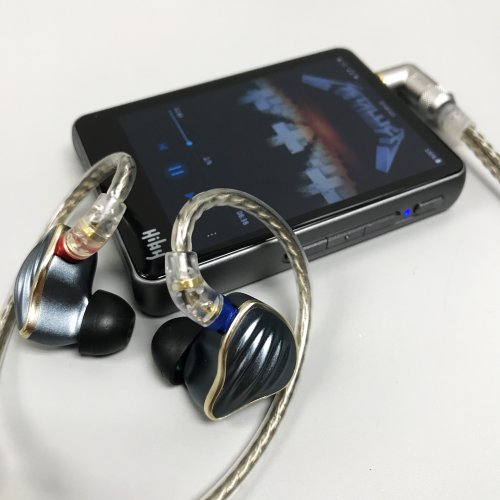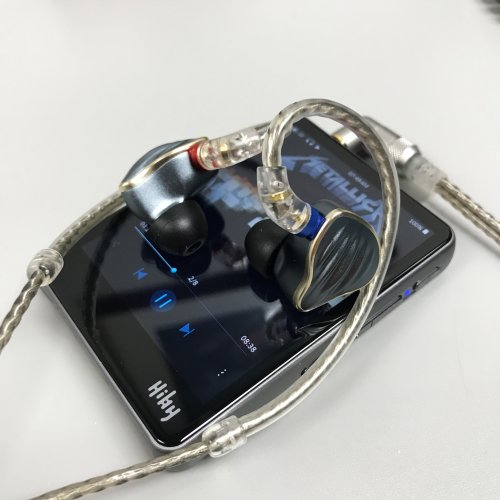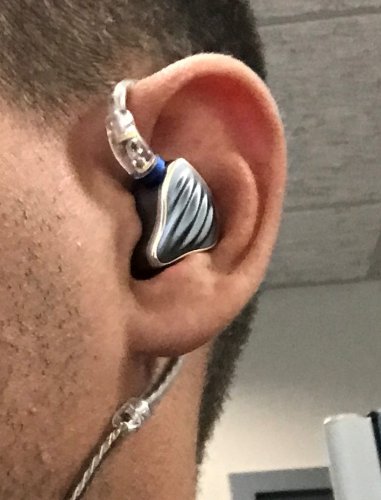Disclaimer:
I purchased the FH5 for personal use with my own money. I didn't participate in the review tour. I'm not affiliated with Fiio in any way. In this review I'll be comparing the FH5 with the Fiio F9Pro and iBasso IT03 (my current benchmark for a U-shaped mid-fi IEM), both of which I've owned and used extensively. My main source is a Hiby R3 and I've been usng them on and off for ~60 hours now.
What I look for in a IEM:
I don't consider myself a really discerning listener. In many cases I can't tell between FLAC and 320 MP3, hence I rarely venture beyond the mid-fi market - just makes little financial sense for me.
My general sound preference is a nice balance between fun and detail - a well extended and mild U-shape, where subbass is a little elevated vs midbass, and the treble's highest peak is at 10kHz. I have small ears, between S and M tip size, depending on insertion depth. To me comfort and design are just as important as sound. My music library includes includes a mix of FLAC and MP3 of classical, jazz, breakbeat, trance, techno, hiphop, pop, hard rock and heavy metal. For a full list of my IEM inventory check my profile.
Some pics:




Non-sound:
They are way smaller in real life than the photos would have you believe - as small as the F9Pro, just a different shape. Fit and comfort are as close as you can get to perfect with a universal-fit shell, even with my small ears - slightly better than my F9Pros and much better than the IT03, whose inserion is so deep that the nozzle edges press against my ear canals. The FH5 shells barely stick out of the ear for a very low profile fit. This is partly because of the shallow insertion depth but I have no problems using single flange tips. I actually welcome the shallow insertion depth as I can experiment with a wider variety of tips like double flanges and foams without the shells sticking out of my ears too much - something I rarely achieve with my other IEMs. Another huge pro is that unlike many mid-fi IEMs the nozzles are ridged so the tip fit is nice and secure.
Speaking of the nozzles the FH5s have 3 separate sound ports for better separation but I'm not convinced the mesh in front of them was a good idea. Sure it protects them from dirt but in my opinion somewhat defeats the purpose of having separate ports, which is why some owners elect to remove it.
Isolation is very good for a vented IEM. For me it's much better than the F9Pro's and on par with the IT03's, which is my benchmark for good open IEM isolation.
The cable is simply gorgeous and doesn't tangle easily. It's little heavy for working out but serviceable. It does retain some memory when wrapped for a while but it's not hard to straighten back to shape. The earhooks are pre-formed tubes, not wire, so you have less freedom in shaping them. I don't mind it but I would've liked the tubes a couple of cm shorter. The MMCX connectors are very tight and secure and I love that they are angled and not straight. It takes a bit of effort to rotate them, unlike with my F9Pro, where the right one is really loose. I just hope the cable wont harden or turn green like most transparent sheathing ones do. It's interesting Fiio didn't choose to include a mic or a balanced cable like they did with the F9Pro but I don't mind at all - don't need either of them and this probably kept the price below $300.
Tip selection is identical to the F9Pro's, with sufficient number of sound enhancing tips. I would've appreciated the inclusion of very wide bore tips for those who want their treble a little more enhanced. My wide-bore shallow-fit Sennheiser tips make the sound signature slightly closer to the F9Pro's. The silicone on Fiio's tips is also a little hard and slippery for my taste. I much prefer using Sony Hybrids when it comes to comfort.
The included case is a very welcome accessory - same as what's included in the F9Pro but clear. Fits the FH5 perfectly and it's much better than what you get from most other brands in this price range.
One thing that I personally dislike about the FH5's design is the golden bezel around the faceplates, and the overall glossiness of the finish. They're sexy when they sit on the table but they get too bling-y for me when in the ear. Almost look like cheap jewelry. I much prefer the F9Pro's subtler matte metallic finish. Hopefully in the future we'll see more color options.
Driving the FH5 is a piece of cake, even with very low power sources. Although their impedance is more than 2x that of the IT03's 8 Ohms, they are the most sensitive IEM I've owned. The 19-Ohm impedance however is not ideal for use with most lower end sources. I get a completely black background from my Hiby R3 on low gain, and directly plugged into my Alienware laptop (Realtek audio chip), but I hear some hiss with my BlueAnt Ribbon bluetooth dongle and my Dell docking station.
Sound:
In the sound department my impressions are in line with Brooko's measurements. The FH5 is not a U/V-shaped IEM. It's more laid back than your typical V-shape, but not flat or overly warm. If you're into measurement graphs, like I am, you'll notice it's very close to the updated IEM Harman curve but its treble doesn't roll off steeply after 2 kHz - something I wholeheartedly approve of. I would define their tuning as "smooth, musical and detailed" and it works well with the wide variety of genres I listen to.
Starting with the sub bass, the rumble is definitely there when called for (on par with the IT03's) and it has substantial extension all the way down to 10 Hz. Midbass drops slightly but is still present and textured, however I find both the F9Pro's and IT03's midbass a little better textured. Because of the elevated mids, the low frequencies often take the back seat, especially on busier tracks like heavy metal. They are back in full strength when playing hip-hop or EDM.
Mids are much more forward than the IT03's, but even though I generally appreciate slightly recessed mids, I wouldn't call the FH5's mids fatiguing, at least not at low-to-moderate listening levels. Regardless, this mid-forwardness makes the FH5 sound very musical and immersive - the vocals and instruments are articulate and present and don't get lost inbetween the low and high frequencies like they sometimes do with U-shaped IEMs.
Highs are where I understandably have my doubts. They aren't too rolled off or at all grainy. They are relatively smooth and have presence all the way up to 17kHz (to my hearing). There are three notable peaks - 7kHz, 12.5kHz, and 16kHz - and each peak is around 3dB lower than the previous.
Unlike some laid back headphones I've tried, "S" sounds don't sound as "SH" and micro-detail and sparkle is there, however cymbal crashes and hihats lack the emphasized sparkle U/V-shaped headphones typically have. This is particularly apparent in tracks where the highs are already recessed. Ideally I would've liked to see another 3-5dB on the second peak, which would increase the sparkle without reaching the piercing levels of the F9Pro. EQing fixes that easily but I prefer not to use EQ if I can.
The upside is that the highs sound more natural than the sometimes metallic highs of a U-shape, and are much more non-fatiguing for extended listening sessions.
In a nutshell:
Design form and function: 8/10 - gorgeous, comfortable, but a bit bling-y, nozzle mesh questionable
Build quality: 10/10 - top notch; well executed connectors
Comfort and seal: 8/10 - great comfort even for small ears; good isolation
Cable: 9/10 - beautiful, comfortable, hard to tangle, a little heavy; earhooks could be better
Accessories: 8/10 - missing wider bore and softer silicone tips; great carrying case
Sound: 9/10 - Smooth, musical, fun, and detailed
Value: 10/10 - Would I recommend them - absolutely, unless you're a treble junkie or a basshead and don't like EQ
Are they an upgrade over the F9Pro or IT03: Depends. They have a different sound signature. That being said, even if I lean towards U-shaped sound I would still take the FH5 over either the F9Pro or the IT03. The FH5 just get so much right that I'm willing to overlook their small flaws.
I purchased the FH5 for personal use with my own money. I didn't participate in the review tour. I'm not affiliated with Fiio in any way. In this review I'll be comparing the FH5 with the Fiio F9Pro and iBasso IT03 (my current benchmark for a U-shaped mid-fi IEM), both of which I've owned and used extensively. My main source is a Hiby R3 and I've been usng them on and off for ~60 hours now.
What I look for in a IEM:
I don't consider myself a really discerning listener. In many cases I can't tell between FLAC and 320 MP3, hence I rarely venture beyond the mid-fi market - just makes little financial sense for me.
My general sound preference is a nice balance between fun and detail - a well extended and mild U-shape, where subbass is a little elevated vs midbass, and the treble's highest peak is at 10kHz. I have small ears, between S and M tip size, depending on insertion depth. To me comfort and design are just as important as sound. My music library includes includes a mix of FLAC and MP3 of classical, jazz, breakbeat, trance, techno, hiphop, pop, hard rock and heavy metal. For a full list of my IEM inventory check my profile.
Some pics:




Non-sound:
They are way smaller in real life than the photos would have you believe - as small as the F9Pro, just a different shape. Fit and comfort are as close as you can get to perfect with a universal-fit shell, even with my small ears - slightly better than my F9Pros and much better than the IT03, whose inserion is so deep that the nozzle edges press against my ear canals. The FH5 shells barely stick out of the ear for a very low profile fit. This is partly because of the shallow insertion depth but I have no problems using single flange tips. I actually welcome the shallow insertion depth as I can experiment with a wider variety of tips like double flanges and foams without the shells sticking out of my ears too much - something I rarely achieve with my other IEMs. Another huge pro is that unlike many mid-fi IEMs the nozzles are ridged so the tip fit is nice and secure.
Speaking of the nozzles the FH5s have 3 separate sound ports for better separation but I'm not convinced the mesh in front of them was a good idea. Sure it protects them from dirt but in my opinion somewhat defeats the purpose of having separate ports, which is why some owners elect to remove it.
Isolation is very good for a vented IEM. For me it's much better than the F9Pro's and on par with the IT03's, which is my benchmark for good open IEM isolation.
The cable is simply gorgeous and doesn't tangle easily. It's little heavy for working out but serviceable. It does retain some memory when wrapped for a while but it's not hard to straighten back to shape. The earhooks are pre-formed tubes, not wire, so you have less freedom in shaping them. I don't mind it but I would've liked the tubes a couple of cm shorter. The MMCX connectors are very tight and secure and I love that they are angled and not straight. It takes a bit of effort to rotate them, unlike with my F9Pro, where the right one is really loose. I just hope the cable wont harden or turn green like most transparent sheathing ones do. It's interesting Fiio didn't choose to include a mic or a balanced cable like they did with the F9Pro but I don't mind at all - don't need either of them and this probably kept the price below $300.
Tip selection is identical to the F9Pro's, with sufficient number of sound enhancing tips. I would've appreciated the inclusion of very wide bore tips for those who want their treble a little more enhanced. My wide-bore shallow-fit Sennheiser tips make the sound signature slightly closer to the F9Pro's. The silicone on Fiio's tips is also a little hard and slippery for my taste. I much prefer using Sony Hybrids when it comes to comfort.
The included case is a very welcome accessory - same as what's included in the F9Pro but clear. Fits the FH5 perfectly and it's much better than what you get from most other brands in this price range.
One thing that I personally dislike about the FH5's design is the golden bezel around the faceplates, and the overall glossiness of the finish. They're sexy when they sit on the table but they get too bling-y for me when in the ear. Almost look like cheap jewelry. I much prefer the F9Pro's subtler matte metallic finish. Hopefully in the future we'll see more color options.
Driving the FH5 is a piece of cake, even with very low power sources. Although their impedance is more than 2x that of the IT03's 8 Ohms, they are the most sensitive IEM I've owned. The 19-Ohm impedance however is not ideal for use with most lower end sources. I get a completely black background from my Hiby R3 on low gain, and directly plugged into my Alienware laptop (Realtek audio chip), but I hear some hiss with my BlueAnt Ribbon bluetooth dongle and my Dell docking station.
Sound:
In the sound department my impressions are in line with Brooko's measurements. The FH5 is not a U/V-shaped IEM. It's more laid back than your typical V-shape, but not flat or overly warm. If you're into measurement graphs, like I am, you'll notice it's very close to the updated IEM Harman curve but its treble doesn't roll off steeply after 2 kHz - something I wholeheartedly approve of. I would define their tuning as "smooth, musical and detailed" and it works well with the wide variety of genres I listen to.
Starting with the sub bass, the rumble is definitely there when called for (on par with the IT03's) and it has substantial extension all the way down to 10 Hz. Midbass drops slightly but is still present and textured, however I find both the F9Pro's and IT03's midbass a little better textured. Because of the elevated mids, the low frequencies often take the back seat, especially on busier tracks like heavy metal. They are back in full strength when playing hip-hop or EDM.
Mids are much more forward than the IT03's, but even though I generally appreciate slightly recessed mids, I wouldn't call the FH5's mids fatiguing, at least not at low-to-moderate listening levels. Regardless, this mid-forwardness makes the FH5 sound very musical and immersive - the vocals and instruments are articulate and present and don't get lost inbetween the low and high frequencies like they sometimes do with U-shaped IEMs.
Highs are where I understandably have my doubts. They aren't too rolled off or at all grainy. They are relatively smooth and have presence all the way up to 17kHz (to my hearing). There are three notable peaks - 7kHz, 12.5kHz, and 16kHz - and each peak is around 3dB lower than the previous.
Unlike some laid back headphones I've tried, "S" sounds don't sound as "SH" and micro-detail and sparkle is there, however cymbal crashes and hihats lack the emphasized sparkle U/V-shaped headphones typically have. This is particularly apparent in tracks where the highs are already recessed. Ideally I would've liked to see another 3-5dB on the second peak, which would increase the sparkle without reaching the piercing levels of the F9Pro. EQing fixes that easily but I prefer not to use EQ if I can.
The upside is that the highs sound more natural than the sometimes metallic highs of a U-shape, and are much more non-fatiguing for extended listening sessions.
In a nutshell:
Design form and function: 8/10 - gorgeous, comfortable, but a bit bling-y, nozzle mesh questionable
Build quality: 10/10 - top notch; well executed connectors
Comfort and seal: 8/10 - great comfort even for small ears; good isolation
Cable: 9/10 - beautiful, comfortable, hard to tangle, a little heavy; earhooks could be better
Accessories: 8/10 - missing wider bore and softer silicone tips; great carrying case
Sound: 9/10 - Smooth, musical, fun, and detailed
Value: 10/10 - Would I recommend them - absolutely, unless you're a treble junkie or a basshead and don't like EQ
Are they an upgrade over the F9Pro or IT03: Depends. They have a different sound signature. That being said, even if I lean towards U-shaped sound I would still take the FH5 over either the F9Pro or the IT03. The FH5 just get so much right that I'm willing to overlook their small flaws.






